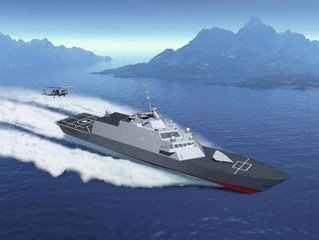
Someone sees a use for the Littoral Combat Ship as a "force integrator" (buzz, buzz) here:
If the Littoral Combat Ship attains the ambitious capabilities imagined by Cebrowski and its other designers, it may well be the ship best-suited to defeating the threats that face U.S. security partners along the Asia littoral. TheThe article also notes that the 3000 ton LCS started out in concept as a 400 ton "Streetfighter," which may be some indication of why Navy procurement is way out of whack. The LCS promises something for everyone and that's a hard promise to make good.
ship was designed, after all, to fight in what U.S. planners call the littoral, anti-access environment against the very challenges Asian countries face.f the Littoral Combat Ship attains the ambitious capabilities imagined by Cebrowski and its other designers, it may well be the ship best-suited to defeating the threats that face U.S. security partners along the Asia littoral. The ship was designed, after all, to fight in what U.S. planners call the littoral, anti-access environment against the very challenges Asian countries face.
In other words, this guy may be right, but there are a whole lotta "ifs" in the mix.
And one must wonder how different things would be if the late Admiral Cebrowski and Capt. Wayne Hughes had been really listened to and somebody with the ability to say "No" to expensive add-ons had been in charge of the LCS project...
Some notes on the original "Streetfighter" concept here:
The Streetfighter would be a smaller, very fast ship (part of the more general Streetfighter concept), that could compete successfully with the enemy for control of coasts and littoral waters. These ships are envisioned as costing less than 10% as much as current Battle Force ships, while comprising more than 25% of the total number of surface combatants [that is at least 25 but no more than 50 units].Why, yes, using a bunch of $90 million ships does make sense when your average destroyer now runs $350 million+, or so it seems to me. And I seriously doubt, as I have said over the years, that the CO of a Billion dollar cruiser is going to want to close the beach for Naval Fire Support missions.
The President of the Naval War College, Admiral Art Cebrowski, and others such as Capt. Wayne P. Hughes, have advocated the deployment of larger numbers of smaller ships to operate in “harm’s way” in littoral waters. Cebrowski and Hughes talk of “tactical instability,” where a navy is unwilling to risk its ships because the fleet is constituted principally of small numbers of expensive ships.
More at MarineLog which suggested the Swedish Visby as a model. Has the money quote: "We've put all our eggs into a few, expensive baskets."
A comparison of the LCS with the Visby here.
And, CDR Salamander has been all over this for a long time. See here and here.


No comments:
Post a Comment